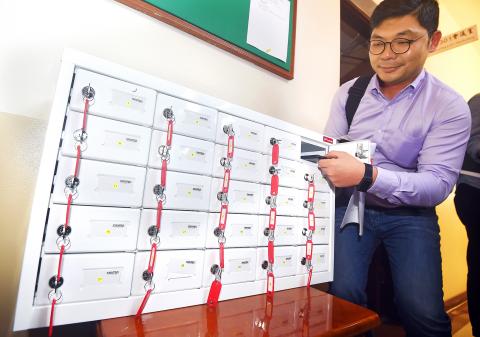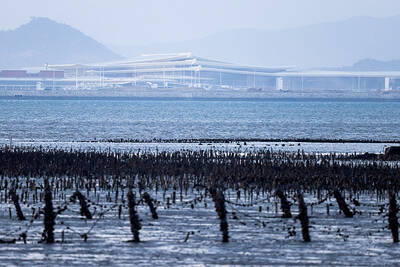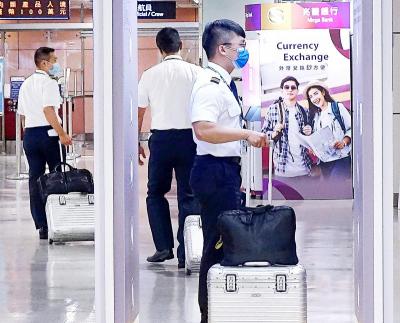Minister of National Defense Yen De-fa (嚴德發) yesterday told lawmakers that the nation’s “Indigenous Defense Submarine” (IDS) program is on track.
The government has set a deadline of March 1 next year for contractor Gavron Ltd, a consultancy based in the British overseas territory of Gibraltar, to submit blueprints for the program’s first phase, Yen said.
Two other key people in charge of the program — Republic of China Navy Commander Admiral Huang Shu-kuang (黃曙光) and Taiwan Shipbuilding Corp (TSBC) chairman Cheng Wen-lon (鄭文隆) — yesterday accompanied Yen to the Legislative Yuan’s National Defense Committee.

Photo: Liao Chen-huei, Taipei Times
Huang was appointed as convener of the “IDS taskforce,” while semi-state owned TSBC was chosen as the main contractor to build a fleet of eight new submarines domestically, with the first vessel to be completed by 2025, reportedly for total budget of NT$500 billion (US$16.13 billion at the current exchange rate).
Yen reiterated that the government and military are fully committed to the program, after some lawmakers suggested other options, such as foreign procurement of submarines equipped with the latest technology and weapons systems.
“Even if the US and other countries were willing to sell us submarines, we would still push through with the IDS program,” Yen said. “We must rely on ourselves and not depend on foreign countries. Taiwan has the industrial capability and technological know-how to make it happen.”
The navy’s submarines are nearing retirement age, Yen said, adding that he was confident TSBC and other Taiwanese naval contractors could successfully bring the program to completion.
The projects could help enhance Taiwan’s expertise and participants would gain experience that they could use to build new warships, submarines and advanced naval weapons, he added.
Lawmakers said they had reports that top Taiwanese officials had over the past month visited Europe and signed a memorandum of understanding with Gavron.
The memorandum requires that Gavron obtain export licenses from the UK government to certify that it is allowed to export military technology, submarine design and construction know-how, and British naval weapons to Taiwan, the lawmakers said.
Yen said Gavron was asked to submit blueprints first.
“We will scrutinize all aspects to ensure full oversight and risk management for this first phase,” he said. “After verification and approval, we will proceed to detailed design planning and then domestic construction of the submarines.”
Chinese Nationalist Party (KMT) Legislator Johnny Chiang (江啟臣) demanded assurances from officials that the process would not be mired in financial impropriety and corruption scandals.
“The Republic of China Navy does not have a good track record,” Chiang said. “There have been many financial scandals and this must not happen to the IDS program.”
Chiang mentioned the probe into corruption surrounding Ching Fu Shipbuilding (慶富造船), which last year defaulted while working on a NT$35.85 billion contract to build six minesweepers for the navy, and the Lafayette frigate scandal in the 1990s, in which arms dealer Andrew Wang (汪傳浦) reportedly pocketed US$500 million in commissions and illicit profiteering on a NT$2.8 billion contract to procure six French navy vessels.
“I can tell you, no intermediaries and no arms dealers who could pocket commissions are involved in the IDS program,” Yen said. “We are dealing directly with the original design company and original manufacturers.”
Lawmakers continued to question the integrity of the tender process, the professional competence of Gavron Ltd and the firm’s ability to obtain export licenses from the UK government.
However, much of the session was conducted behind closed doors between lawmakers, and a handful of top defense and IDS officials.

Three Taiwanese airlines have prohibited passengers from packing Bluetooth earbuds and their charger cases in checked luggage. EVA Air and Uni Air said that Bluetooth earbuds and charger cases are categorized as portable electronic devices, which should be switched off if they are placed in checked luggage based on international aviation safety regulations. They must not be in standby or sleep mode. However, as charging would continue when earbuds are placed in the charger cases, which would contravene international aviation regulations, their cases must be carried as hand luggage, they said. Tigerair Taiwan said that earbud charger cases are equipped

Foreign travelers entering Taiwan on a short layover via Taiwan Taoyuan International Airport are receiving NT$600 gift vouchers from yesterday, the Tourism Administration said, adding that it hopes the incentive would boost tourism consumption at the airport. The program, which allows travelers holding non-Taiwan passports who enter the country during a layover of up to 24 hours to claim a voucher, aims to promote attractions at the airport, the agency said in a statement on Friday. To participate, travelers must sign up on the campaign Web site, the agency said. They can then present their passport and boarding pass for their connecting international

UNILATERAL MOVES: Officials have raised concerns that Beijing could try to exert economic control over Kinmen in a key development plan next year The Civil Aviation Administration (CAA) yesterday said that China has so far failed to provide any information about a new airport expected to open next year that is less than 10km from a Taiwanese airport, raising flight safety concerns. Xiamen Xiangan International Airport is only about 3km at its closest point from the islands in Kinmen County — the scene of on-off fighting during the Cold War — and construction work can be seen and heard clearly from the Taiwan side. In a written statement sent to Reuters, the CAA said that airports close to each other need detailed advanced

The age requirement for commercial pilots and airline transport pilots is to be lowered by two years, to 18 and 21 years respectively, to expand the pool of pilots in accordance with international standards, the Ministry of Transportation and Communications announced today. The changes are part of amendments to articles 93, 119 and 121 of the Regulations Governing Licenses and Ratings for Airmen (航空人員檢定給證管理規則). The amendments take into account age requirements for aviation personnel certification in the Convention on International Civil Aviation and EU’s aviation safety regulations, as well as the practical needs of managing aviation personnel licensing, the ministry said. The ministry